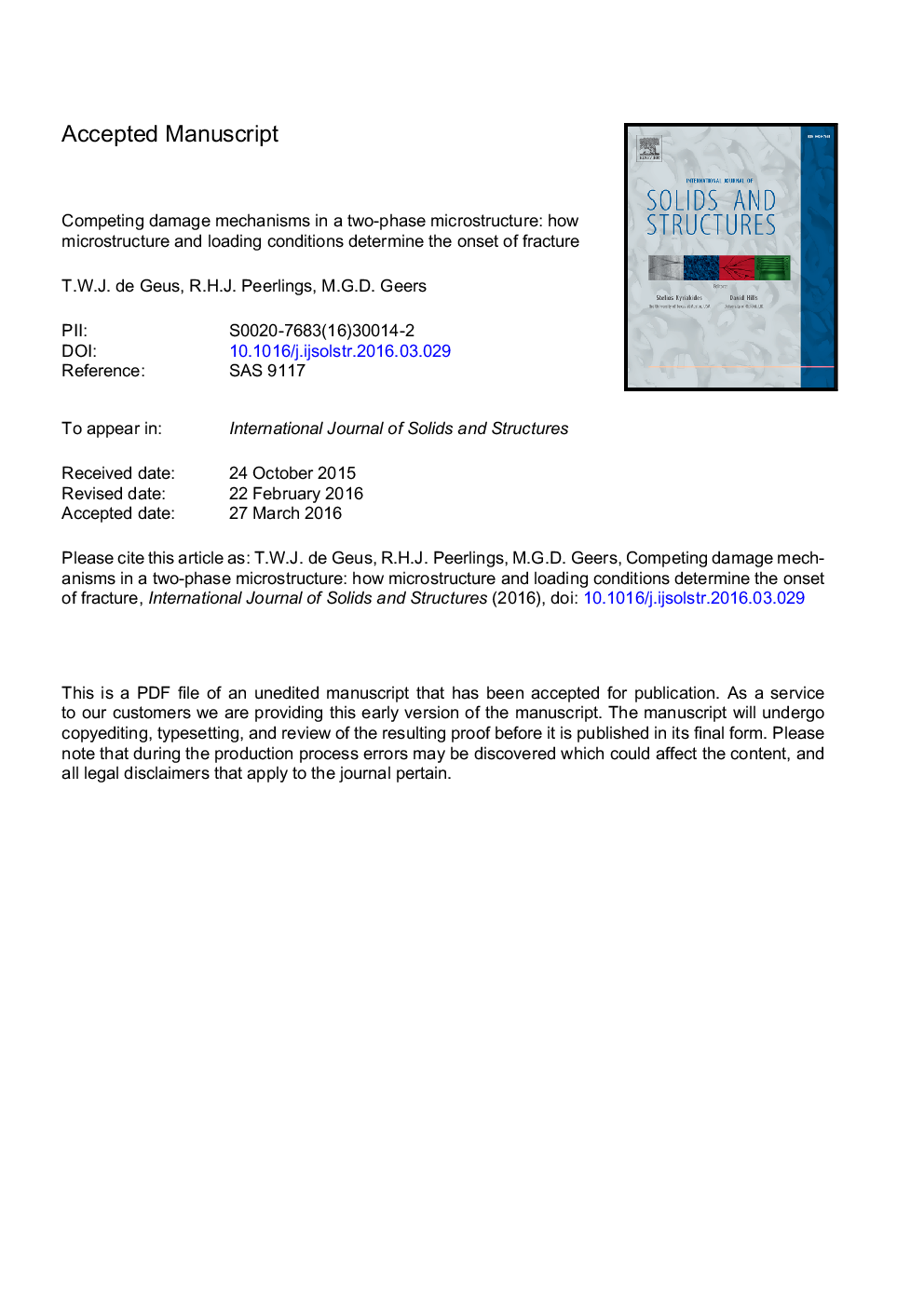| کد مقاله | کد نشریه | سال انتشار | مقاله انگلیسی | نسخه تمام متن |
|---|---|---|---|---|
| 4922826 | 1430197 | 2016 | 22 صفحه PDF | دانلود رایگان |
عنوان انگلیسی مقاله ISI
Competing damage mechanisms in a two-phase microstructure: How microstructure and loading conditions determine the onset of fracture
ترجمه فارسی عنوان
سازوکارهای آسیب پذیری در یک ریز ساختار دو فاز: چگونگی ریزساختار و شرایط بارگذاری، بروز شکستگی را مشخص می کند
دانلود مقاله + سفارش ترجمه
دانلود مقاله ISI انگلیسی
رایگان برای ایرانیان
کلمات کلیدی
چند مقیاس، میکرومکانیک، خسارت، شکستگی، مواد چند فاز،
ترجمه چکیده
در این مقاله رقابت شروع شکستگی در مرحله نرم افزاری و در مرحله سختی نسبتا شکننده در ریز ساختار یک ماده دو فاز مورد بررسی قرار می گیرد. یک مدل میکروساختار ساده برای پیش بینی شروع شکستگی ماکروسکوپی استفاده می شود. سادگی مدل تضمین محاسبات بسیار کارآمد را فراهم می کند، یک مطالعه جامع: طیف گسترده ای از فاز حجم فاز سخت و نسبت استرس عملکرد، برای طیف گسترده ای از شرایط استرس اعمال می شود. هر ترکیبی از این پارامترها با استفاده از یک مجموعه بزرگ (ریزپردازنده) ریز ساختارها مورد تجزیه و تحلیل قرار می گیرد. مشاهده شده است که تنها یک مرحله از شروع شکستگی ماکروسکوپی حاکم است: در سه وجهی استرس کم فاز نرم است غالب است، اما بیش از سه برابر شدن بحرانی، فاز سخت است که موجب کاهش شدید ورق می شود. این انتقال به شدت به پارامترهای ریز ساختار وابسته است. اگر فاز حجم فاز سخت کوچک باشد، شروع شکستگی توسط فاز نرم حتی در کنتراست فاز بالا تحت سلطه قرار می گیرد. در فاز جامد فاز بالاتر فاز سختی در حال حاضر در کنتراست فاز کم قرار دارد. این مدل ساده به این ترتیب مشاهدات تجربی از ادبیات را برای ترکیب خاصی از پارامترها، که ممکن است بیانیه های متناقض را در گذشته منجر شده است، تطبیق دهد. تجزیه و تحلیل میکروسکوپی نشان می دهد که توزیع فاز متوسط در اطراف سایت های شروع شکستگی تقریبا برای دو مکانیسم شکست است. در امتداد جهت کشش، مناطق فاز سخت به طور مستقیم در کنار محل شروع شکستگی یافت می شوند. این "باند" فاز سخت از طریق سایت شروع به شکست با "نوارهای" فاز نرم با ترمیم برش متقاطع است. واضح است که ناسازگاری مکانیزم محلی برای شروع شکستگی غالب است، صرف نظر از اینکه شکست در مرحله نرم و یا سخت آغاز می شود.
موضوعات مرتبط
مهندسی و علوم پایه
سایر رشته های مهندسی
مهندسی عمران و سازه
چکیده انگلیسی
This paper studies the competition of fracture initiation in the ductile soft phase and in the comparatively brittle hard phase in the microstructure of a two-phase material. A simple microstructural model is used to predict macroscopic fracture initiation. The simplicity of the model ensures highly efficient computations, enabling a comprehensive study: a large range of hard phase volume fractions and yield stress ratios, for wide range of applied stress states. Each combination of these parameters is analyzed using a large set of (random) microstructures. It is observed that only one of the phases dominates macroscopic fracture initiation: at low stress triaxiality the soft phase is dominant, but above a critical triaxiality the hard phase takes over resulting in a strong decrease in ductility. This transition is strongly dependent on microstructural parameters. If the hard phase volume fraction is small, the fracture initiation is dominated by the soft phase even at high phase contrast. At higher hard phase volume fraction, the hard phase dominates already at low phase contrast. This simple model thereby reconciles experimental observations from the literature for a specific combination of parameters, which may have triggered contradictory statements in the past. A microscopic analysis reveals that the average phase distribution around fracture initiation sites is nearly the same for the two failure mechanisms. Along the tensile direction, regions of the hard phase are found directly next to the fracture initiation site. This 'band' of hard phase is intersected through the fracture initiation site by 'bands' of the soft phase aligned with shear. Clearly, the local mechanical incompatibility is dominant for the initiation of fracture, regardless whether fracture initiates in the soft or in the hard phase.
ناشر
Database: Elsevier - ScienceDirect (ساینس دایرکت)
Journal: International Journal of Solids and Structures - Volumes 97â98, 15 October 2016, Pages 687-698
Journal: International Journal of Solids and Structures - Volumes 97â98, 15 October 2016, Pages 687-698
نویسندگان
T.W.J. de Geus, R.H.J. Peerlings, M.G.D. Geers,
